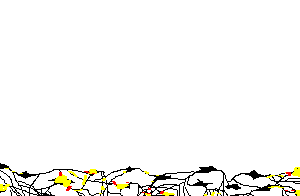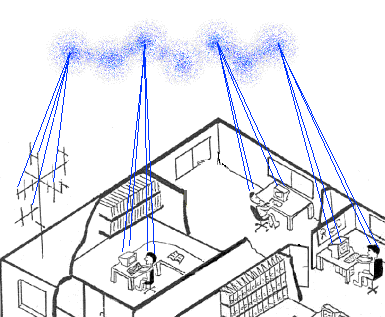Organizational Reports in
Neural Companies
|
|
|
| Human
thinking would not work the way it does without the
existence of some reliably addressable informations
ressources. Admittedly, each one of us may have
completely different contents in his working space of
consiousness when presented with the word „Channel“.
The important thing is, that within one brain, the
information addressed by such a word is constant enough
to play a defined role in complex information processes.
The animation below shows what happens: |
|
Channel:
Calais, Dover, TV, rain, ferry, irrigation, funnel,
grooving, mainstream, Tirpitz, Brittany, King Arthur,
Magellan Straits, oil fields, Dunkerque, Sandwich,
P&O, Hovercraft |

Consciousness as
"mental reports"
|
|
 more pictures, drawings and animated.gifs about
neural companies more pictures, drawings and animated.gifs about
neural companies |
The
animation shows
- how the nervous activity of a biological network
(bottom) evokes some definite and unified content
of consciousness (top left)
- how this content of consciousness is involved in
some sort of information processing (top)
- and how the result is fed back to the underlying
neural network (top right)
|
|
 Tor Norretranders on the function of symbols Tor Norretranders on the function of symbols |
The same
applies to the standard working mode of a manager in a
large enough company:
- gathering dissipated data from heterogeneous
sources (E-Mail, reports, phone calls, letters,
publications...) and unifying that data into a
definite bunch of information
- processing this information (meetings, individual
pondering) to produce some result
- writing back that result into the material
reality of the company (E-Mail, notes, phone
calls, intranet etc.)
|
|
|

A manager in a company
doing knowledgework
|
|
|
| So, to
support this mode of knowledge work, it is firts of all
important to help in the context-embedded gathering of
dissipated data. Already, financial data is made
available in a highly standardized form to meet the rigid
demands of professional accountancy. Software systems
offer specified „reports“. But controlling,
monitoring and other technical data are also increasingly
shaped and moulded into reliable reports. The driving
forces behind this tendency are manifold. The wish to
employ standardized software, the demands for
transparency and clear definitions of processes as laid
down in various norms such as ISO 9000, the growing need
to provide electronic data in an interchangeable format
and, last but not least, the growth of intra- and
internet structures where the exploding amount of
information can only be met with the creation of reliable
methods of retrieval. |
|
|
| In a
number of years, the by far largest proportion of
organizational knowledge will be stored in computer
systems. Knowledge workers will rely heavily on
standardized sources of information. |
|
|
Digression: a large mining company
|
|
|
| Small
companies are not large enough to be treated
statistically in the sense we want to. Average nations,
however, are too big to be treated as an individual with
some sort of unifying groupware making any sense. So
something inbetween like a large company with at least
some few thousand employees will do better. A
differentiated organizational structure, too, is needed.
And the complexity of the whole thing should be well
beyond the grasp of even the most intelligent human
individual. |
|
|
| So, for
the sake of illustration, imagine a large mining company
with many divisional branches spread across the globe. |
|
|
| Open-pit
copper mines on the southern hemisphere, newly developed
underground coal mines in the former Soviet Union, the
exploration and exploitation of off-shore gas and oil
fields and the mining of complex polymetallic ore bodies
at various locations are only some of the company’s
key-engagements. Besides, the company runs two global
selling organizations. It is doing active research into
milling, coking, geophysics and metallurgy. And the
company entertains a worldwide network of lobbyism,
public relations and widely appreciated sponsoring.
Through some of its products, its name is explicitly
known to most consumers of even the most basic
constituents of the western life-style. |
|
|
There is a
headquarter somewhere in Europe, but many activities are
managed on the spot without much interference from HQ.
However, many issues need central coordination:
- Should financial ressources be allocated to
research & development activities concerning
sustainable sources of energy? And if so, to what
amount and how can this be best coordinated with
public relations and lobbyisms with legislative
bodies in Europe and America?
- How will copper prices develop over the coming
years and at what costs will the company be able
to produce?
- Which part of the overall budget should go into
which field of research?
- What is the right public announcement in answer
to a public outcry against the company’s
engagement in a politically controversial region?
- What are the company`s chances to get engaged in
mining activities in a region not yet covered?
By taking a closer look at the last example, we will
try to identify some helpful mechanism to reduce the
complexity of the issue in order to reach an optimum
answer. These, of course, will correspond to some
phenomena in the human brain, as will be shown.
|
|
|
| Suppose it
is your task to make well founded suggestions for future
mining engagement anywhere on the globe. And let us
further take it for granted that most of the information
you may need is available electronically. |
|
|
Starting
from scratch, you load a work-flow sheet (just another
report) labelled „new mining engagements“ onto
your screen and switch into the „internet mode“
of knowledge work. The work-flow is a very good guideline
and offers many sources of information that you should
consult to get a first impression of viable potentials
for further elaboration:
| Title |
Type |
Description |
| mineral markets of the world |
intranet site |
long term prognostications of
mineral markets |
| mineral deposits |
internet site |
maps, geology, mineralogy and
geography |
| world mining report |
internet site |
legal, financial and
entrepeneurial issues worldwide |
| strategic finances |
intranet site |
the company`s long term
financial planning |
| comany mining expertise |
intranet site |
mining techniques currently in
use |
| company R & D potentials |
intranet site |
current, past and planned R
& D activities |
| competitors’ review |
intranet site |
portal of the company`s
„secret service“ |
| sleeping tigers of the world |
internet site |
somewhat exotic futurology on
politcs and economis |
| global miners company newsgroup |
discussion forum |
company issues of international
relevance |
Scanning over the titles and the short descriptions of
the ressources can be compared to evaluating the first
images and words that come to ones mind when working out
the tomorrows shopping tour. The deeper contents of the
ressources are yet vague and you have to opt for one of
them. In the case of the mining company, you may chose to
start with a general overview of the mineral deposits.
You open the site and you are then confronted with maps
to click on and with further links to follow up.
Depending on your disposition and circumstances, you may
then stick to your work-flow or you may plunge into the
fascinating world of geology and mineralogy of the
world...
|
|
|
| A report
in this sense need not be identical with a physically
compact storage of information. It can better be
described as some standardized access to more or less
constant themes and topics. In practise, it is more like
a personalized portal to some specific topic than a
static list of facts. |
|
|
| However,
don`t forget that your time is limited. Your telephone
may ring any time to call you to some meeting, or your
boss may give you some other most urgent work, or you may
get ill one of the coming days. So the order of working
through the knowledge ressources is most important.
Missing some hint on a competitor’s activities, for
instance, may invalidate completely the the result of
your work. |
|
|
| So once
again we are confronted with the importance of priorising
links. This leads us back to the concept of synaptic
weighing and it is left up to the reader to acknowledge
the importance of this for any individual worker by
analysing his own workaday office life. |
|
|
| In
consequence, the tendency towards structuring knowledge
in organizations will be flanked by a growing focus on
producing various forms of reports for various situations
and various people. The techniques for this are already
being developed, albeit against different backgrounds.
And they will only have to be merged into what my
fittingly be called „synaptic browsers“ to
emulate the internet mode of thinking that takes place in
our mental life. |
|
|

The gathering of
dissipated data in a company
|
|
<=
Metaphysical speculations on the nature of consciousness |
|
|
|
 |
 |
| one level up |
top level |
|
|

contact
|